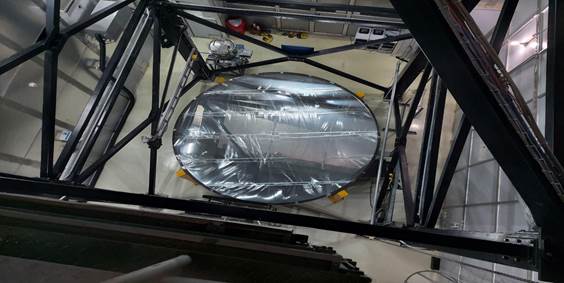

Top view of the ILMT located at the Devasthal Observatory of ARIES showing the liquid mercury mirror covered by a thin mylar film.
Union Minister Jitendra Singh inaugurated Asia’s largest 4-metre International Liquid Mirror Telescope (ILMT) at the Aryabhatta Research Institute of Observational Sciences (ARIES) in Uttarakhand’s Nainital today.
“Today’s landmark event, places India at a different and a much higher level of capabilities to study the mysteries of the skies and astronomy, and to share the same with the rest of the world,” the minister of state of science and technology said.
While scanning the strip of the sky every night, the telescope will generate nearly 10-15 Gigabytes of data and the wealth of ILMT generated data will permit the application of Big Data and Artificial Intelligence/Machine Learning (AI/ML) algorithms that will be implemented for classifying the objects observed with the ILMT, the minister explained.
The Aryabhatta Research Institute announced that the world-class 4-metre International Liquid Mirror Telescope is now ready to explore the deep celestial sky. The telescope is located at an altitude of 2450 metre at the Devasthal Observatory campus of ARIES, an autonomous institute under the Department of Science and Technology (DST).
Dr Jitendra Singh informed that the ILMT collaboration includes researchers from ARIES in India, the University of Liège and the Royal Observatory of Belgium in Belgium, Poznan Observatory in Poland, the Ulugh Beg Astronomical Institute of the Uzbek Academy of Sciences and National University of Uzbekistan in Uzbekistan, the University of British Columbia, Laval University, the University of Montreal, the University of Toronto, York University and the University of Victoria in Canada.
The telescope was designed and built by the Advanced Mechanical and Optical Systems (AMOS) Corporation and the Centre Spatial de Liège in Belgium.
Dr Jitendra Singh said, the ILMT employs a 4-metre-diameter rotating mirror made up of a thin layer of liquid mercury, to collect and focus light.
The Minister informed that the data will be analyzed quickly to discover and discern variable and transient stellar sources. The 3.6 metre DOT, with the availability of sophisticated back-end instruments, will allow rapid follow-up observations of the newly-detected transient sources with the adjacent ILMT.
There are primarily three components in a liquid mirror telescope: i) A bowl containing a reflecting liquid metal (essentially mercury), ii) an air bearing (or motor) on which the liquid mirror sits, and iii) a drive system.
Dr Jitendra Singh said it was primarily the patronage, promotion and prioritization from Prime Narendra Modi that has enabled and emboldened the scientific fraternity to successfully try new initiatives, one after the other, in the field of science, technology and innovation, which are being rated as world class.
Taiwan detected one sortie of Chinese aircraft, eight Chinese vessels and one official ship until…
Baloch activist Mahan Baloch delivered a powerful intervention that shed light on the ongoing human…
Prime Minister Narendra Modi spoke with the Myanmar military junta chief, Min Aung Hlaing, and…
The United Nations Human Rights Council (UNHRC) witnessed a strong intervention from Jamil Maqsood, the…
Union Home Minister Amit Shah on Saturday hailed the success of security forces in a…
India has launched 'Operation Brahma' to support earthquake-impacted Myanmar. Indian Air Force C-130 J aircraft…